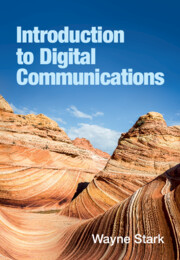Refine search
Actions for selected content:
3527 results in Wireless Communications

Aerial Access Networks
- Integration of UAVs, HAPs, and Satellites
-
- Published online:
- 19 October 2023
- Print publication:
- 02 November 2023

Introduction to Digital Communications
-
- Published online:
- 24 April 2023
- Print publication:
- 16 March 2023
-
- Textbook
- Export citation
Dedication
-
- Book:
- Introduction to Digital Communications
- Published online:
- 24 April 2023
- Print publication:
- 16 March 2023, pp vi-vi
-
- Chapter
- Export citation
Index
-
- Book:
- Introduction to Digital Communications
- Published online:
- 24 April 2023
- Print publication:
- 16 March 2023, pp 648-650
-
- Chapter
- Export citation
Reviews
-
- Book:
- Introduction to Digital Communications
- Published online:
- 24 April 2023
- Print publication:
- 16 March 2023, pp ii-iii
-
- Chapter
- Export citation
9 - Convolutional Codes
-
- Book:
- Introduction to Digital Communications
- Published online:
- 24 April 2023
- Print publication:
- 16 March 2023, pp 557-596
-
- Chapter
- Export citation
Acknowledgments
-
- Book:
- Introduction to Digital Communications
- Published online:
- 24 April 2023
- Print publication:
- 16 March 2023, pp xiv-xiv
-
- Chapter
- Export citation
4 - Error Probability for Binary Signals
-
- Book:
- Introduction to Digital Communications
- Published online:
- 24 April 2023
- Print publication:
- 16 March 2023, pp 196-249
-
- Chapter
- Export citation
References
-
- Book:
- Introduction to Digital Communications
- Published online:
- 24 April 2023
- Print publication:
- 16 March 2023, pp 645-647
-
- Chapter
- Export citation
1 - Fundamentals of Digital Communications
-
- Book:
- Introduction to Digital Communications
- Published online:
- 24 April 2023
- Print publication:
- 16 March 2023, pp 1-45
-
- Chapter
- Export citation
5 - Optimal Receivers for M-ary Communication
-
- Book:
- Introduction to Digital Communications
- Published online:
- 24 April 2023
- Print publication:
- 16 March 2023, pp 250-294
-
- Chapter
- Export citation
3 - Probability, Random Variables, Random Processes, Signal Bandwidth
-
- Book:
- Introduction to Digital Communications
- Published online:
- 24 April 2023
- Print publication:
- 16 March 2023, pp 143-195
-
- Chapter
- Export citation
Copyright page
-
- Book:
- Introduction to Digital Communications
- Published online:
- 24 April 2023
- Print publication:
- 16 March 2023, pp v-v
-
- Chapter
- Export citation
Abbreviations
-
- Book:
- Introduction to Digital Communications
- Published online:
- 24 April 2023
- Print publication:
- 16 March 2023, pp xv-xvi
-
- Chapter
- Export citation
Appendices
-
- Book:
- Introduction to Digital Communications
- Published online:
- 24 April 2023
- Print publication:
- 16 March 2023, pp 597-644
-
- Chapter
- Export citation
Appendix B: - Trigonometric and Fourier Transform Identities
-
- Book:
- Introduction to Digital Communications
- Published online:
- 24 April 2023
- Print publication:
- 16 March 2023, pp 616-617
-
- Chapter
- Export citation
Appendix D: - Simulation of Signals and Noise
-
- Book:
- Introduction to Digital Communications
- Published online:
- 24 April 2023
- Print publication:
- 16 March 2023, pp 624-644
-
- Chapter
- Export citation
6 - Modulation Techniques
-
- Book:
- Introduction to Digital Communications
- Published online:
- 24 April 2023
- Print publication:
- 16 March 2023, pp 295-344
-
- Chapter
- Export citation
Contents
-
- Book:
- Introduction to Digital Communications
- Published online:
- 24 April 2023
- Print publication:
- 16 March 2023, pp vii-x
-
- Chapter
- Export citation
7 - Wireless Channels and Transmission Techniques
-
- Book:
- Introduction to Digital Communications
- Published online:
- 24 April 2023
- Print publication:
- 16 March 2023, pp 345-432
-
- Chapter
- Export citation
